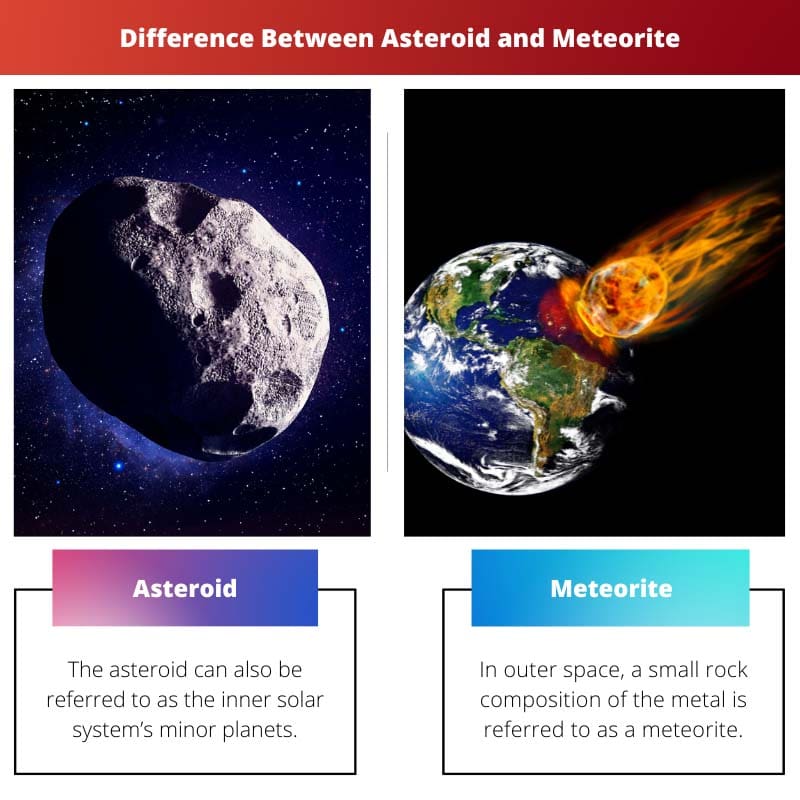When it comes to the universe, there is a countless range of objects orbiting the sun. It may be fair to say rocks like meteorites and asteroids from space inspire both fear and wonder among us earthlings.
Meanwhile, knowing how they differ and more about each might eliminate potential misgivings.
Both asteroids and meteorites are commonly called celestial bodies, which share a few common things, like staying close to the planet.
Two of them traced their origin from space, but they have distinctive names up to their location. In this article, the chief aim is to differentiate asteroids and meteorites.
Key Takeaways
- Asteroids are small, rocky celestial bodies orbiting the Sun, while meteorites are fragments of celestial objects, such as asteroids or comets, that have fallen to Earth’s surface.
- Asteroids are primarily found in the asteroid belt between Mars and Jupiter, while meteorites can be discovered on Earth after surviving their passage through the atmosphere.
- Asteroids are composed of rock and metal, while meteorites can be classified into three main types: stony, iron, and stony-iron, based on their composition.
Asteroid vs Meteorite
Asteroids are rocky objects that orbit the Sun in the asteroid belt between Mars and Jupiter or in other solar system regions. Meteorites are asteroid fragments that have survived the journey through Earth’s atmosphere and have impacted the ground, composed of rock, metal, or both.

The asteroid can also be referred to as the inner solar system’s minor planets. In the asteroid belt, there are approx asteroids in millions. The asteroid belt, which has its location between Mars and Jupiter, has more than 750,000 asteroids.
According to experts, one or two comparison moons have few asteroids.
In outer space, a small rock composition of the metal is referred to as a meteorite. While taking entry into the earth’s atmosphere, meteorites eventually completely vaporize and fail to reach the surface.
During descent, meteorite burn and mainly creates a light trail.
Comparison Table
| Parameters of Comparisons | Asteroid | Meteorite |
|---|---|---|
| Origin | Leftover from the planet | Small disintegrated element of an asteroid or comet |
| Location | In space | Reach the surface of the planet |
| Size | In diameter, 1 to more than 100 kilometers | Less than 10 meters |
| Discovery | By Giuseppe Piazzi in 1801 | By Harvey H. Nininger in 1959 |
| Atmosphere | Do not have | Burn up when falling |
What is Asteroid?
Historically, the term asteroid has been applied to astronomical objects mainly orbiting the sun.
It was failed to observe to have active comet characteristics like a tail. This time eventually refers to the inner solar system’s minor planets comparison that co-orbital with Jupiter.
Planetoids can be described as large asteroids. There is the existence of millions of asteroids in which many are planetesimal’s shattered remnants bodies within a general solar nebula of young sun that fails to grow large enough to result as a planet.
The known asteroid’s vast majority orbit within the chief asteroid belt is located between Jupiter and Mars’s orbit or is co-orbital with Jupiter. However, the existence of other orbital families with significant populations comprises near-earth objects.
Various asteroid dynamic groups have been discovered, chiefly orbiting in the inner solar system. The other bodies’ gravity perturbs the orbits in the solar system and through the Yarkovsky effect.
The asteroid belt, trojans, and near-earth asteroids are three of the significant populations.

What is Meteorite?
In outer space, a meteorite is a metallic or a small rocky object for the body. Objects smaller than meteorites can be categorized as space dust or micrometeoroids.
Most of them are fragments from asteroids or comets, while others are debris of collision impact ejected from bodies like Mars.
When a meteorite takes place into Earth’s atmosphere at speed in 20 km/s excess, then aerodynamic heating of that object results in light’s streak. As a result, both from the glowing object and the glowing particles trail that it leaves in its wake.
An estimated 25 million micrometeoroids are meteorites and other space debris that mainly enter the Earth’s atmosphere daily. This results in that material’s estimated 15,000 tons entering the atmosphere every year.
Most of them have originated from the asteroid belt.
Almost all meteorite comprises extraterrestrial iron and nickel. They have three chief categorizations: stony iron, stone, and iron. Some stones comprise grain-like inclusions referred to as chondrules. Achondrites are stony meteorites lacking these features.

Main Differences Between Asteroid and Meteorite
- Asteroids are made of metals, rocks, and other elements. Astronomers say some might comprise water. On the contrary, meteorites comprise silicates and iron and nickel as metals.
- In terms of etymology, the word asteroid is derived from the Greek word, namely, asteroids which means starlike. Meanwhile, the word meteorite is a combination of two words: meteor and ite.
- The instance of the word asteroid usage in a sentence is that “an asteroid hitting earth might be an event of cataclysmic.” On the other hand, “the meteorite left an impact crater of approx 40 miles wide” is an instance of word meteorite usage in a sentence.
- Some famous asteroid names include Icarus, Hathor, Ceres, Pallas, and Hermes. On the flip side, Orionids, hoba, perseids, geminids, and Leonids are some of the names of famous meteorites.
- When it comes to orbit, asteroids have elliptical orbits in which the distance from the sun fails to vary too much. In contrast, meteorites also have elliptical orbits, but meteors get pulled into larger bodies, such as planets, due to their mass.

References
- https://onlinelibrary.wiley.com/doi/abs/10.1111/j.1945-5100.1993.tb00755.x
- https://ui.adsabs.harvard.edu/abs/2002cem..book…..N/abstract
